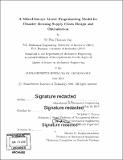| dc.contributor.advisor | Stephen C. Graves. | en_US |
| dc.contributor.author | Yip, So Han Florence. | en_US |
| dc.contributor.other | Massachusetts Institute of Technology. Department of Mechanical Engineering. | en_US |
| dc.date.accessioned | 2019-09-17T19:48:31Z | |
| dc.date.available | 2019-09-17T19:48:31Z | |
| dc.date.copyright | 2019 | en_US |
| dc.date.issued | 2019 | en_US |
| dc.identifier.uri | https://hdl.handle.net/1721.1/122226 | |
| dc.description | Thesis: S.M., Massachusetts Institute of Technology, Department of Mechanical Engineering, 2019 | en_US |
| dc.description | Cataloged from PDF version of thesis. | en_US |
| dc.description | Includes bibliographical references (pages 191-195). | en_US |
| dc.description.abstract | Every year, natural disasters such as hurricanes and wildfires wreak havoc on U.S. territory, causing significant property damages and displacing many. At times of presidentially-declared disasters, many survivors look to the Federal Emergency Management Agency (FEMA) for recovery support. In particular, FEMA may provide temporary disaster homes, such as manufactured housing units and recreational vehicles, to those whose primary homes have been severely damaged and uninhabitable. In this thesis, a mixed-integer linear programming (MILP) model has been developed to evaluate and compare various potential disaster housing supply chain configurations. For a user-configured supply chain network and disaster scenario, the MILP model computes the optimal procurement strategy and corresponding flow, and evaluates the resulting time and cost profile of response. To evaluate the performance of the network in light of the uncertainty it faces, we solve the MILP for a large set of randomly generated potential scenarios. We used the MILP model to perform multiple sensitivity analyses to illustrate the performance and operation dynamics of the supply chain, as well as to show how to identify improvement opportunities to increase the efficiency, both in terms of disaster home delivery and costs incurred. | en_US |
| dc.description.statementofresponsibility | by So Han Florence Yip. | en_US |
| dc.format.extent | 195 pages | en_US |
| dc.language.iso | eng | en_US |
| dc.publisher | Massachusetts Institute of Technology | en_US |
| dc.rights | MIT theses are protected by copyright. They may be viewed, downloaded, or printed from this source but further reproduction or distribution in any format is prohibited without written permission. | en_US |
| dc.rights.uri | http://dspace.mit.edu/handle/1721.1/7582 | en_US |
| dc.subject | Mechanical Engineering. | en_US |
| dc.title | A mixed-integer linear programming model for disaster housing supply chain design and optimization | en_US |
| dc.type | Thesis | en_US |
| dc.description.degree | S.M. | en_US |
| dc.contributor.department | Massachusetts Institute of Technology. Department of Mechanical Engineering | en_US |
| dc.identifier.oclc | 1119388753 | en_US |
| dc.description.collection | S.M. Massachusetts Institute of Technology, Department of Mechanical Engineering | en_US |
| dspace.imported | 2019-09-17T19:48:28Z | en_US |
| mit.thesis.degree | Master | en_US |
| mit.thesis.department | MechE | en_US |
